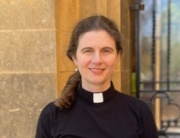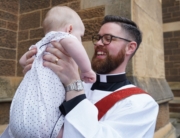Love Bade Me Welcome – a Lenten sermon series by The Rev’d Canon Jenny Wilson

Lent 1: Love Bade Me Welcome
– A Spirituality of a Cathedral
The Nave (number 1 of 4)
10 March 2019
The Rev’d Canon Jenny Wilson
In the name of God, creating, redeeming, sanctifying… Amen.
Love bade me welcome: yet my soul drew back,
Guilty of dust and sin.
But quick-eyed Love, observing me grow slack
From my first entrance in,
Drew nearer to me, sweetly questioning
If I lacked anything.
“A guest,” I answered, “worthy to be here”:
Love said, “You shall be he.”
“I, the unkind, ungrateful? Ah, my dear,
I cannot look on thee.”
Love took my hand, and smiling did reply,
“Who made the eyes but I?”
“Truth, Lord; but I have marred them; let my shame
Go where it doth deserve.”
“And know you not,” says Love, “who bore the blame?”
“My dear, then I will serve.”
“You must sit down,” says Love, “and taste my meat.”
So I did sit and eat.
Love bade me welcome –this poem by George Herbert that invites us into pondering a spirituality of our Cathedral.
In this Festival year we are focussing on many different aspects of this building that is, and has been, precious for so many over these 150 years. During Lent in our Festival of Living Faith, the Dean is exploring our journey into God in the mornings, and for four evenings we will ponder the spirituality of this place focussing on four different aspects, the Nave, the Choir, the Altar and the Flags. Four sermons cannot begin to exhaust the depth of this our cathedral building but I hope at least to begin our reflections.
The idea for this series comes from a book written by a former Dean of Westminster Abbey, Michael Mayne, entitled Pray, Love Remember. In this book, written for Lent, Michael Mayne devotes each of his chapters to a place in the Abbey, reflecting on the particular meaning for him of that place, remembering some of the key events that took place there and including excerpts from his diaries. Many of the other ideas for this series of sermons will come from parishioners and particularly Rosie Hamilton and other tour leaders who through my time here have generously given their own particular insights into what inspires them about the cathedral. I am particularly indebted to Bill Goodes who wrote a “Spirituality Tour of the Cathedral” to help me with these sermons. Bill’s tour is beautiful and I have asked that the text be placed on the Cathedral website.
Love bade me welcome. Well, us welcome, really.
We enter the cathedral through an open door and we enter it from the world. One wonderful aspect of our cathedral is its almost always open door. Blessed by welcomers who give generously of their time and seem so often to graciously delight in meeting strangers from across the globe, the building whose spires reach to the sky, lifting our eyes and hearts from the streets and the daily concerns of our lives, invites us in. Surrounding our cathedral are signs of so many aspects of the world from which we come, a busy street, an oval, a garden with a cross of sacrifice, offices, hospitals, cafes and shops, places devoted to education, religious and otherwise, bus stops with children waiting not always patiently for the journey home.
The incarnation is about God being with us in a particular time and place, God alongside us wherever we are, whatever our circumstances, God forgiving our failures, leading us through times of struggle.
As we enter the cathedral the nave opens out before us. William Butterfield who made the original design for the cathedral, a design which Edward Woods took over and modified, planned a single large space that would embrace all worshippers each with their own part to play. The word nave comes from the Latin word for ship. The building helps us see ourselves embarking on a journey, surely for those who designed and crafted and now care for this building, a journey of faith in God who we know in Christ. Our lives of faith begin, traditionally, with the sacrament of baptism and so it is fitting that the font, where baptism takes place, is just inside the door. The nave seems to invite us to sit and take part as we so often do week by week at services and on occasion at concerts but the nave also invites us to move along this journey. The aisle is a place of movement and the end of our journey is seen if we lift up our eyes. Christ in glory is portrayed on the reredos, one of the many visual guides to our story of faith which rises beautifully up above the high altar. This image may or may not speak to us of heaven, the great mystery of our home in death, but what matters is that our faith speaks of death not as a defeat, an extinguishing, but as a part of human and created life that is inhabited by God. Has been inhabited and defeated by Jesus. All our life and our death are embraced by this faith and the nave of our cathedral images this truth.
The open door and the nave invite us into a story. Michael Mayne reflects on this: “The Church’s chief task is to be the living reminder in every age of the divine story, a reminder in its annual recounting of the stories of Christmas, Holy Week, Easter and Pentecost, names which describe how the Christ-like God has acted within the confines of history. Actions which are definitive for all future time but which are spelled out in the homely language of one man’s life and teaching and healing, and loving and forgiving, and suffering and dying. Our task is to make connections between his story and ours, between our little lives and the great life of God within us, but also (for example, and more remarkably) between our sufferings and God’s suffering in Jesus Christ. For not only is that connection one of the central truths on which Christian belief rests, it is also the most comforting and affirming reality, and the starting point to turn whatever suffering we may have to face to creative ends.”[1]
We are invited into a story, God’s story. This story is told in word and sacrament, in music, glass, wood and stone. The key image of this story is the cross, Jesus’ cross and this cathedral is in the shape of a cross. During Choral Evensong through Lent the story of Jesus’ Passion is told, reminding us of the centrality of this story as we prepare for Holy Week during the precious piece of time that is Lent.
We will spend time on the telling of the story of Jesus next week when we reflect on the Choir of this cathedral, the place where the music is sung, the organ played. The gathered community is held in the nave whilst these story tellings spread out before us; the nave is the place where we ponder and pray, where we sit and hear, where we reach out to one another with open hands saying each time we gather for Holy Communion, “Peace be with you.”
“Peace be with you.” The words in which we affirm, what God surely knows and hopes we will know, the value of each person seated around us. Friend and stranger, those whose lives and struggles we hold dear and those we have never met, those, perhaps, who have caused us pain and who we long to forgive. God’s peace is offered to one another in the heart of the nave. Our gathering together in the nave and the peace we offer one another reminds us that we must, in Michael Mayne’s words about his Abbey, “witness to the truth that every single human being, even the brassiest, gum-chewing, T-shirted travel-weary tourist ‘stands each in the splendour of its own existence’ and is of unique worth in the sight of God.”[2] Our Dean often reminds us that our cathedrals’ ministry is threefold – for our own community, for the diocese for whom we are “mother church” and for the city. Our welcoming and gathering in the nave reminds us of the truth that each of these ministries is of utter value to God.
The primary purpose for which we gather is worship. Michael Mayne writes that “those who built our churches created spaces intended to arouse in those who entered them a sense of entering a special space, evoking a sense of awe which is the beginning of worship. A space in which the offering of the Opus Dei, [the daily work of God], day in, day out, year in, year out, for centuries has created a kind of holy rhythm that has invaded the very stones.”[3] Perhaps not quite centuries for our cathedral in its 150th anniversary, but we know what he means – and we commit ourselves to the centuries ahead.
Each weekday at 7.30am, we embrace this holy rhythm as we celebrate the Eucharist in the Lady Chapel, the small communities that have gathered often joining one another for breakfast in one of the cafes nearby after the service. Each weekday at 8.45am we say Morning Prayer, remembering day by day each month the names of all who are on our cathedral roll. Each Wednesday at 5.30pm, we sing Choral evensong praying for parishes in our diocese and lighting candles for peace in the world… and then there is Sunday. The Eucharist is celebrated twice on Sunday morning and evensong is sung on Sunday night, gathering in the nave regular members of our congregation and visitors, those who wish to become involved and build friendships and those who wish to be left in peace to drink in the worship alone.
Our cathedral doors open to gather in and welcome all who enter into the nave with a sense that what they have entered is the house of God, the great love of God, the story of God. And then the doors open to send us out. Blessed by this love we might go into the world to share that love perhaps, to speak of the story of God who we know in Christ, to encourage one another to offer welcome to strangers, to give generously to those in need. To see the world a little more as God sees it, loved, blessed, broken, oh so loved. As George Herbert said,
Love bade me welcome: yet my soul drew back,
Guilty of dust and sin.
But quick-eyed Love, observing me grow slack
From my first entrance in,
Drew nearer to me, sweetly questioning
If I lacked anything.
Next week we’ll
ponder a little our souls drawing back, guilty of dust and sin. As we reflect
on what we call the Choir, the place where music is sung and played, the place
where the psalms are chanted, the place where the love and forgiveness of God
is known in ways that our minds cannot quite understand.
[1] Michael Mayne Pray, Love, Remember pp76-7.
[2] Michael Mayne p8.
[3] Michael Mayne p19.





